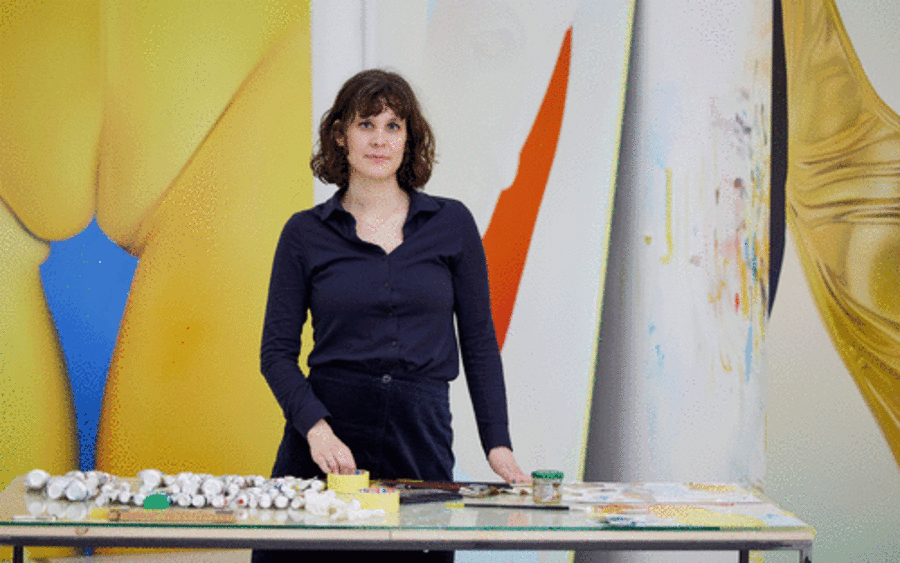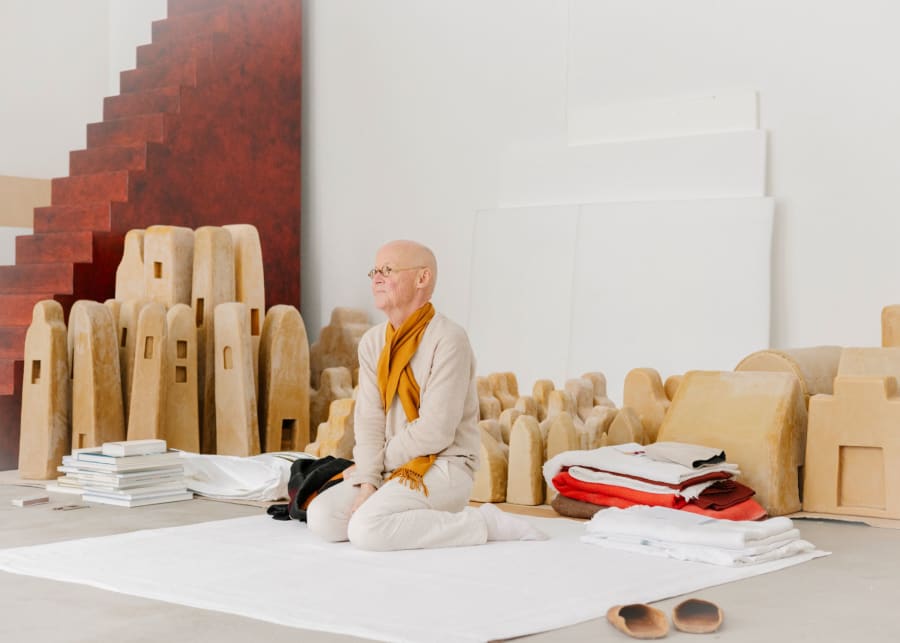Thirteen performers wearing multicolored, everyday clothing are clustered together in two uneven groups at the front of Hamburger Bahnhof’s monumental main hall. Some are standing, others crouch, yet all raise their arms above their heads, using them to carve through space in their own unique ways, at times finding moments of unison. Suddenly, four surge forward. In doing so, they initiate a ripple effect – their castmates run in waves to join them and organize themselves into a new formation.
This is a scene from Attune, a new major site-specific installation by Alexandra Pirici at Hamburger Bahnhof. Kicking off the museum’s recently developed annual commission for the historic main hall, the work aims to explore how humans and non-humans resemble, influence, and attune themselves to one another. The fact that Pirici has used performative action and choreography to do so comes as no surprise: Initially trained in classical ballet before gravitating towards more contemporary and conceptual movement practices, throughout her career the Romanian artist has become known for staging ongoing public actions that arrange performers into formations she describes as ‘living sculptures.’ In Attune, much of her choreographic inspiration comes from starling murmurations, how 'flocks of birds move across the skies to produce seemingly large organisms.'
However, what’s new in Attune is the context in which her choreography takes place. Not only is Hamburger Bahnhof’s hall the largest-scale venue Pirici has staged her work in to date, her performers act amid an intricate landscape of sculptural elements that deepen the investigation of attunement.
This new scenographic development in Pirici’s otherwise body-focused practice was enabled by the support of Audemars Piguet Contemporary, the art program of the Swiss watchmaker, which co-commissioned Attune following its support of Pirici’s Encyclopedia of Relations at the 59th Venice Biennale. ‘What’s important for us is that our support can allow our artists to experiment with something they haven’t had a chance to before,’ says Denis Pernet, curator at Audemars Piguet Contemporary. ‘They have carte blanche freedom to imagine anything they want. We have no theme or requirements.’
Pirici certainly made the most of this boundless opportunity: The sculptures she has created push the limits not only of her practice but also of what is physically possible to display in a museum context. A vast sand dune, for example, takes up a large portion of the space, acting as a natural element that organically self-structures. Elsewhere, a metal tree-like sculpture rises from the ground and entwines itself with the lattice beams of the hall’s arcades. From it hang translucent cylinders, some of which house chemical gardens in glass tubes – Technicolor scenes resembling coral, plants, and fungi formed by dissolving metal salts into solutions of sodium silicate. Others showcase oscillating chemical reactions, such as a scaled-up version of the Briggs-Rauscher reaction, in which three clear liquids rush into the cylinder, change color into a deep yellow, then a dark, squid-ink blue, and magically dissolve back and forth between the two until the reaction is completed.
While Pirici acquired chemical knowledge, collaborating with scientists from Freie Universität Berlin and the University of Bucharest, and even set up a laboratory in Hamburger Bahnhof to prepare these chemical processes, she sees her engagement with science in Attune as an extension of her performance practice. ‘I’m interested in expanding the range of what can perform and what can be active. The material aspect of chemistry can be really wondrous, very active, and very performative,’ she says. As such, a crucial part of Attune is about encouraging dialogue between artistic and scientific approaches, the latter of which she thinks has been viewed as reductionist and mechanistic over the past few years. ‘You can think poetically and tell wonderful stories about the world that are also grounded in contemporary science. There need not be a distinction between scientific fact and beautiful metaphors.’
The potential for dialogue between art and science and living and non-living matter is most effectively illustrated in Attune when the human performers interact with their non-human counterparts. Some performers roll in fetal-like positions down the dune, leaving gentle imprints on it as they descend; one engages in a duet with a rock, mirroring its curved form with their body, while others cross their arms in gestures mirroring the hall’s geometric architecture. In a standout moment, one performer articulates her voice to the oscillating colors of the Briggs-Rauscher reaction, sliding up to higher notes when the yellow hue appears and plummeting suddenly to a deeper pitch when it switches to blue. Through these moments of exchange, Pirici wants to emphasize that there is ‘no fundamental difference between our bodies and a piece of stone, the building blocks are just arranged differently.’ She’s celebrating that ‘we are all part of the same material fabric.’
These interactions require awareness, observation, and listening to be executed effectively. As a result, they make a statement about the importance of empathy and collaboration in an age characterized by overstimulation, individualism, and polarity. The Georgian and Corsican-inspired polyphonic chants – scores including different, and at times dissonant, voices – sung intermittently throughout the performance reinforce this message. ‘[Polyphony is] difficult to perform and sometimes to properly listen to,’ Pirici says. ‘There’s an interesting political value in it. I don’t think we are practicing the capacity to listen to different voices at the same time and to find a common harmony, or a common ground.’
Pirici’s performers will be present in Attune for four hours each day for its entire five-month run at Hamburger Bahnhof – an impressive length of time considering the challenges of ongoing performative works. ‘After COVID, we thought that performance art had perhaps suffered in comparison to other practices,’ Pernet says of Audemars Piguet Contemporary’s dedication to supporting the art form, which is shared by Hamburger Bahnhof. ‘Hamburger Bahnhof’s collection is rich in holdings of time-based media – sound art, film, and a growing repertoire of performances that have been acquired after they’ve been commissioned for our space,’ says Dr. Sam Bardaouil, Co-director of the institution. ‘It was important for us that this commission had a performative aspect, and that we gave it prime real estate, to signal our commitment to fostering and nurturing this strand of contemporary art.’
Those who visit outside Attune’s official performance times will still get a sense of the installation’s liveness. ‘Even when the human performers are not there, the non-human performers are still at work,’ says the exhibition’s curator, Dr. Catherine Nichols. ‘They’re always moving, transforming, and shapeshifting,’ she adds, referencing a landslide on the dune she witnessed the other morning. The glass cylinders can also comically gurgle and produce bubbles at irregular moments, cheekily demanding visitors’ attention.
Visitors may even feel like performers as they move through and establish their relationships with Pirici’s sculptures. While it’s not possible for anyone but the performers to roll down the dune, at the beginning of the exhibition, there is an invitation to stir a solution of mica powder and oil and to closely observe the resulting Rayleigh-Bénard convection cells that form and demonstrate how non-living matter can self-organize. It’s a clever way to encourage people to slow down and pay attention to small details before encountering the rest of Pirici’s landscape that, despite being largely non-biological, is teeming with life.
Alexandra Pirici’s Attune will be on view at Hamburger Bahnhof, Berlin, through October 6, 2024. Live action will take place for four hours each day during the exhibition period. The Briggs-Rauscher reaction can be experienced twice daily during the opening and closing weeks of the exhibition. The work was co-commissioned by Hamburger Bahnhof and Audemars Piguet Contemporary and highlights the shared mission to support contemporary artists in developing and furthering their practices. For more information, please visit Audemars Piguet Contemporary – Alexandra Pirici: Attune.
Emily May is a British-born, Berlin-based writer specializing in dance and performance.
Caption for all the images: Alexandra Pirici. Photo: Courtesy of the artist, Hamburger Bahnhof, and Audemars Piguet.
Published on April 29, 2024.


